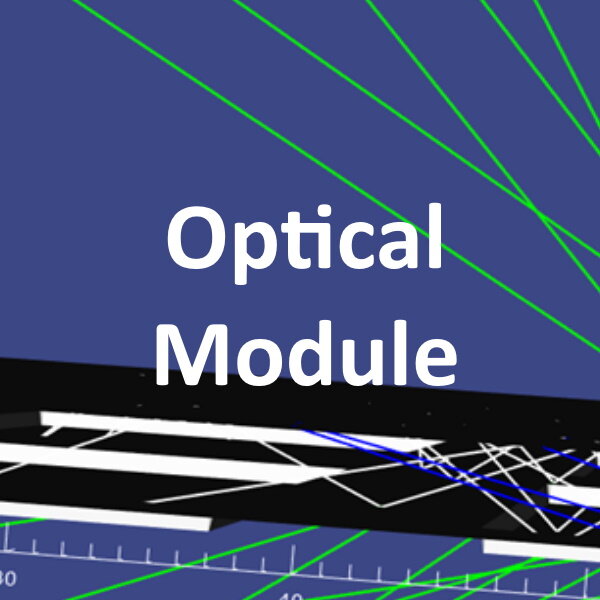Laoss
Software to Design and Optimize Large Area Semiconductor Devices
Electrical Module - Thermal Module - Optical Module - Publications - Brochure

Overview and Workflow

Laoss (large-area organic semiconductor simulation) is a powerful software package for the design, simulation, and optimization of large-area organic and perovskite solar cells and LEDs (displays, lighting panels, photovoltaic arrays).
-
Get started quickly on Finite-Element-Analysis (FEA)
-
FEM based electro-thermal modeling
-
Powerful 3d ray tracing for concentrator PV
-
Wide range of different output data and comprehensive result visualization.
-
High-speed computation on standard PCs
-
Intuitive, easy to use Graphical User Interface (GUI) and workflow
-
Laoss-Setfos integration
Contact us today to receive a free 1 month evaluation license Try Laoss For 1 Month
Laoss Module Options
We offer three modules with Laoss: Optical, Electrical, and Thermal. The optical and electrical modules can be purchased separately. The thermal module requires a license of the electrical module and considers electro-thermal coupling.
1. The Laoss Electrical Module

The Laoss electrical module can simulate the characteristics of displays, large-area OLEDs, and perovskite/organic solar cells including mini-modules (current-voltage curves, total power dissipation, fill factor vs. conductivity, 2D-distribution of the electrical potential…).
The applications of the Laoss electrical module include:
-
Optimization of the electrode design. Reduction of electrical losses.
-
Studying non-ideal effects in OLEDs and solar cells (e.g. electrical shunts)
-
Understanding electrical cross-talk in RGD OLED pixel array.
2. The Laoss Electro-Thermal Module
The thermal module can be used to simulate the two-way interaction between heat generation and the electrical properties of a semiconductor. It enables the following applications:

-
Calculating the temperature distribution in OLEDs and solar cells under standard operations. The illustration shows the temperature distribution in a 4-cell OPV mini-module.
-
Studying the impact of shunts or layer non-uniformities on the distribution of the temperature and the electrical potential.
-
Explaining non-ideal IV characteristics of OLEDs and solar cells due to electrothermal coupling.
-
Coupled electro-thermal model to simulate the two-way interaction between heat generation and electrical properties of the semiconductor.
This electro-thermal module is coupled to the electrical module and requires a license for both modules.
Contact us today to receive a free 1 month evaluation license
3. The Laoss Optical Module

The Laoss optics module is a powerful 3D ray-tracer solver used to:
-
Simulate in- and out-coupling in OLEDs and solar cells with complex 3D optical elements or surface texturing.
-
Model stand-alone 3D optical elements and their contribution to the device.
-
Simulate optical cross-talk in OLED displays.
-
Easily coupled to setfos to analyze OLEDs and PVs with complex light-coupling geometries.
Laoss optics is designed for typical use cases in OLED and Organic/Perovskite PV research. Our software provides more than a generic 3D ray-tracing package and can produce a layered approach for defining a simulated device. Laoss directly accepts output from our software setfos (Emission profile, Reflection/Transmission profile, BSDF) thus providing a fully comprehensive design and simulation package for researchers.

Laoss Platform
The Graphical User Interface (GUI) has an intuitive layout and will display your OLED or solar cell designs and simulation results in a format that is suitable for detailed analysis and publication. You can easily import your custom-made geometry in Laoss and start the meshing with few clicks. Laoss will perform a check of the geometry you imported to avoid problems with the meshing.

Research Papers using Laoss
You can also have a look at the complete Publication List.

Modelling crosstalk through common semiconductor layers in AMOLED displays, L. Pennick et al. J. Soc. Inf. Display 26, 546 (2018) https://onlinelibrary.wiley.com/doi/abs/10.1002/jsid.671

Quantitative analysis of pixel crosstalk in AMOLED displays, M.Diethelm et al. Journal of Information Display, 19:2, 61-69, DOI: 10.1080/15980316.2018.1428232


Electrothermal simulation of large-area semiconductor devices, C. Kirsch et al. The International Journal of Multiphysics , 11 (2) https://doi.org/10.21256/zhaw-1984
Finite element modeling for analysis of electroluminescence and infrared images of thin-film solar cells, M. Diethelm, et al. Solar Energy 209, 186 (2020). https://doi.org/10.1016/j.solener.2020.08.058
Specification
Intended Users: Research scientists, large enterprise businesses, mid-size businesses, academic institutions.
Applicable Research Fields: Light Emitting Devices, OLEDs, perovskite/organic solar cells, perovskite solar cell simulation, semiconductor devices, curved displays, lighting panels, and photovoltaic arrays, simulate OLED upscaling.
Devices Supported: Windows, Linux
Supported Countries: Worldwide
Supported Languages: English
Support Options: Knowledge base, Online Support, Phone Support, Video Tutorials (all included with license)
Pricing
Pricing Model: Annual license fee per user
Tutorial
The Laoss tutorial video below which is presented by our CEO Beat Ruhstaller demonstrates how intuitive the software is to use and how quickly it can compute simulation results. The tutorial video covers:
-
Simulation of large area semiconductor devices (OLED, thin-film PV)
-
Coupling law input: analytical or tabulated (experimental or simulated) IV curve
-
Device optimization (electrode material, device geometry etc...)
Off course if you decide to purchase a software licence for laoss, full technical support is included at no additional cost.









